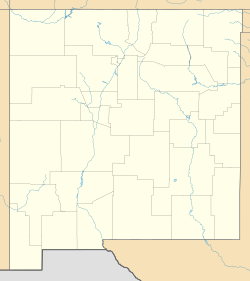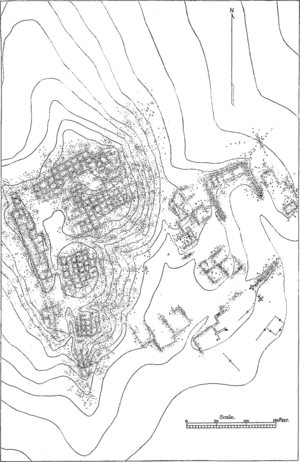Hawikuh Ruins facts for kids
|
Hawikuh
|
|
|
U.S. National Historic Landmark District
Contributing Property |
|

Ruins of Mission La Purísima Concepción de Hawikuh, photo circa 1886
|
|
| Nearest city | Zuni, New Mexico |
|---|---|
| Area | 10 acres (4.0 ha) |
| Built | 1539 |
| Part of | Zuni-Cibola Complex (ID74002267) |
| NRHP reference No. | 66000502 |
Quick facts for kids Significant dates |
|
| Added to NRHP | October 15, 1966 |
| Designated NHL | October 9, 1960 |
| Designated NHLDCP | December 2, 1974 |
Hawikuh (also spelled Hawikku) was one of the largest Zuni pueblos when Spain first explored the area. The name means "gum leaves" in the Zuni language. It was built around the year 1400 AD. Hawikuh was the first pueblo to be visited and taken over by Spanish explorers.
The site of this ancient village is about 12 miles (19 km) southwest of Zuni Pueblo. It is located on what is now the Zuni Indian Reservation in Cibola County, New Mexico. In 1960, the site was named a National Historic Landmark. It is known as the Hawikuh Ruins. It is also part of a larger group of important historical places called the Zuni-Cibola Complex.
Hawikuh's Early History
In 1539, a man named Estevanico was the first non-native person to visit Hawikuh. He was an enslaved North African who was part of an expedition led by Fray Marcos de Niza. Estevanico had become known as a medicine man. He was one of the few people to survive a previous Spanish journey.
When Estevanico arrived at Hawikuh, he had many turquoise stones and was with some women. These were gifts from other Native American groups he had met. The Zuni people at Hawikuh were very smart. They made Estevanico stay in a small hut outside their village. The older men and leaders talked about why he had come.
After three days, they decided he might be a spy. They thought he was guiding others who wanted to conquer them. They also didn't like that he asked for turquoise and women. So, they decided to kill him. They did not harm the people who came with him. About 60 people were allowed to return home. These scared people met the Spanish friars about 60 leagues (around 180 miles) away. They told them the sad news, which made the friars very afraid.
Spanish Conquest and Missions
In 1540, Francisco Vázquez de Coronado led a Spanish expedition and conquered Hawikuh. He had hoped to find one of the legendary "Seven Cities of Gold" there. Coronado was very disappointed because there was no gold. He wrote that the people seemed to worship water because it helped their corn grow.
Coronado described the pueblo houses: "Although they are not decorated with turquoises, nor made of lime or good bricks, nevertheless they are very good houses, with three, four, and five stories, where there are very good apartments ... and some very good rooms underground Kivas, paved, which are made for winter and have something like hot baths."
Some Hawikuh residents ran away to a mesa top called Dowa Yalanne to escape Coronado's attackers. The 14 buildings on Dowa Yalanne were used as a safe place from the Spanish between 1540 and 1680. These buildings were called Heshoda Ayahltona, meaning "ancient buildings above."
In 1628, the Spanish built a church at Hawikuh called Mission La Purísima Concepción de Hawikuh. The Spanish tried to stop the Zuni people from practicing their own religion. They also made the Zuni work for them using a system called encomienda.
In 1632, the Zuni people at Hawikuh rebelled. They burned the church and killed the priest. In 1672, Apache raiders burned the church again. Then, in 1680, it was burned one more time during the Pueblo Revolt. This was a big uprising when all the pueblos in Nuevo México fought against the Spanish. After this revolt, the Zuni people left Hawikuh for good.
Hawikuh Today
Hawikuh is located within the Zuni Indian Reservation near Zuni, New Mexico. The ruins of Hawikuh were dug up by archaeologists between 1917 and 1923. This work was led by Frederick Webb Hodge for the Heye Foundation.
The things found during these digs, like tools and pottery, are now kept at the National Museum of the American Indian. This museum got the collection in 1989. Hawikuh was officially named a National Historic Landmark in 1961.
See also
 In Spanish: Hawikuh para niños
In Spanish: Hawikuh para niños




